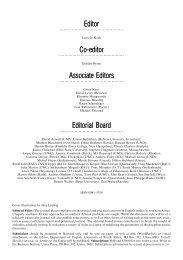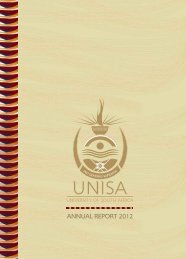Download the Annual report 2011 - Unisa
Download the Annual report 2011 - Unisa
Download the Annual report 2011 - Unisa
You also want an ePaper? Increase the reach of your titles
YUMPU automatically turns print PDFs into web optimized ePapers that Google loves.
<strong>Unisa</strong> is <strong>the</strong> largest open distance learning (ODL) institution<br />
in South Africa and on <strong>the</strong> continent, and one<br />
of <strong>the</strong> world’s mega-institutions. <strong>Unisa</strong> enrols nearly<br />
one-third of all South African students. The student profile<br />
reflects South Africa’s democratisation process and<br />
its status on <strong>the</strong> continent since 1994, underscoring <strong>the</strong><br />
pivotal role that <strong>Unisa</strong> plays in higher education, and its<br />
strategic position on <strong>the</strong> continent and in <strong>the</strong> world as a<br />
key vehicle for transformation, growth and development.<br />
As it has developed and matured into an effective and<br />
efficient 21st century university since <strong>the</strong> merger with<br />
Technikon SA in 2004, <strong>Unisa</strong>’s institutional and management<br />
structures have been continually adapted and<br />
adjusted to meet emerging regulatory requirements,<br />
socioeconomic dynamics and institutional transformation<br />
and growth requirements. The top management for<br />
<strong>2011</strong> reflects <strong>the</strong> most recent iteration of that process<br />
(refer to page 9).<br />
The institution has embraced <strong>the</strong> fact that it needs to<br />
adapt quickly to <strong>the</strong> fast-paced higher education environment<br />
of <strong>the</strong> 21st century and this is reflected in its<br />
management style and leadership practice. <strong>Unisa</strong><br />
continues to operate in an environment characterised by<br />
pressing and complex challenges, emanating largely<br />
from <strong>the</strong> ongoing transformation imperative. Key among<br />
<strong>the</strong>se are: unrelenting demands for access to higher<br />
education by school-leavers, many of whom are underprepared<br />
for <strong>the</strong> rigours of university education;<br />
unachievable and perhaps unrealistic enrolment ratios<br />
and targets; increasing <strong>report</strong>ing requirements over a<br />
broad planning and governance front; and a shrinking<br />
academic cohort of appropriately qualified academic<br />
staff.<br />
UNISA ANNUAL REPORT <strong>2011</strong><br />
| 5 |<br />
In line with its ODL character, <strong>Unisa</strong> must also implement<br />
<strong>the</strong> upgrading and integration of all of its ICT and<br />
o<strong>the</strong>r systems and processes, and <strong>the</strong> ongoing rationalisation<br />
of <strong>the</strong> programme qualification mix (PQM)<br />
toward a more efficient and effective matrix of qualifications<br />
on offer. The ICT implementation plans have<br />
been constrained to some extent by <strong>the</strong> national ICT<br />
infrastructural environment whose disparities echo those<br />
which exist in <strong>the</strong> country, and whose affordability and<br />
availability are extremely concerning in <strong>the</strong> context of<br />
ODL. <strong>Unisa</strong> is, however, working in a concerted manner<br />
to overcome <strong>the</strong> challenges and to provide quality<br />
distance education to all of its students, and has spent<br />
large sums of money to support <strong>the</strong> ICT initiatives. This<br />
focus is clearly evidenced in Goal 7 of <strong>Unisa</strong> 2015 revisited<br />
which asserts: “Redesign organisational architecture<br />
in line with institutional strategy and <strong>the</strong> ODL model.”<br />
Additionally, <strong>Unisa</strong>’s commitment to being a highperformance<br />
university demands a thorough embedding<br />
of <strong>the</strong> emerging plethora of governance and sustainability<br />
dynamics, principles and practices across <strong>the</strong> institution<br />
in line with strategic Goal 6 to establish <strong>Unisa</strong> as<br />
a leader in sound corporate governance and <strong>the</strong> promotion<br />
of sustainability. Multi-, inter- and trans-disciplinary<br />
(MIT) research was also a key focus area for <strong>2011</strong>,<br />
toge<strong>the</strong>r with <strong>the</strong> promotion of indigenous knowledge<br />
systems (IKS) and <strong>the</strong> creation of courses that can be<br />
used as open educational resources (OER) and for<br />
e-learning, as set out in Goal 2: “Increase innovative<br />
research and research capacity.”<br />
Much of <strong>the</strong> work will be described in more detail in this<br />
<strong>report</strong>, which sets out <strong>Unisa</strong>’s operations and performance<br />
for <strong>2011</strong>. Any fur<strong>the</strong>r information that may be<br />
required on any matter in this <strong>report</strong> may be located<br />
on <strong>the</strong> <strong>Unisa</strong> website or by contacting <strong>the</strong> office of <strong>the</strong><br />
University Registrar by email at molaml@unisa.ac.za.

















